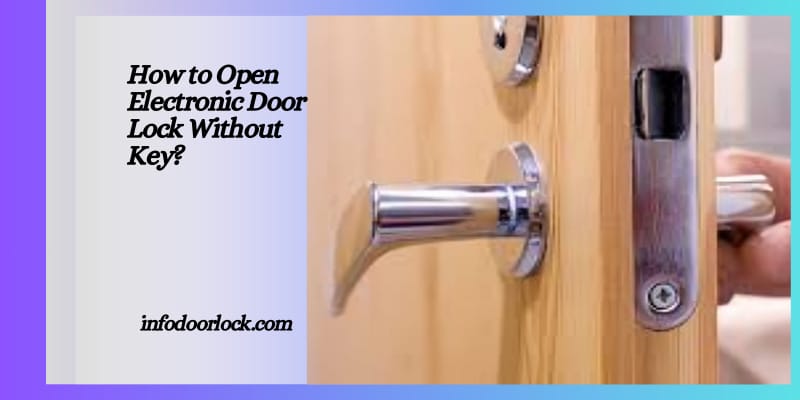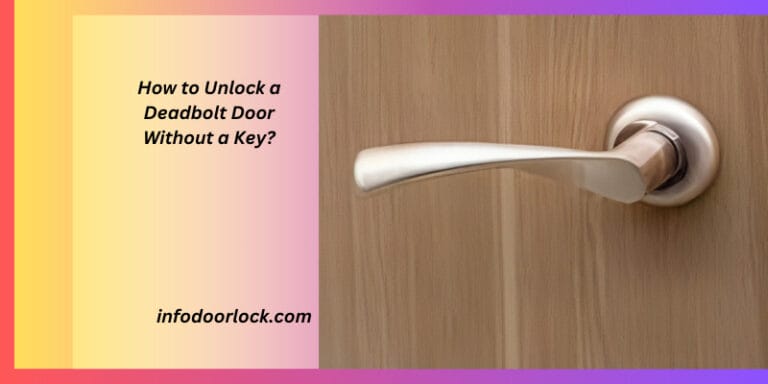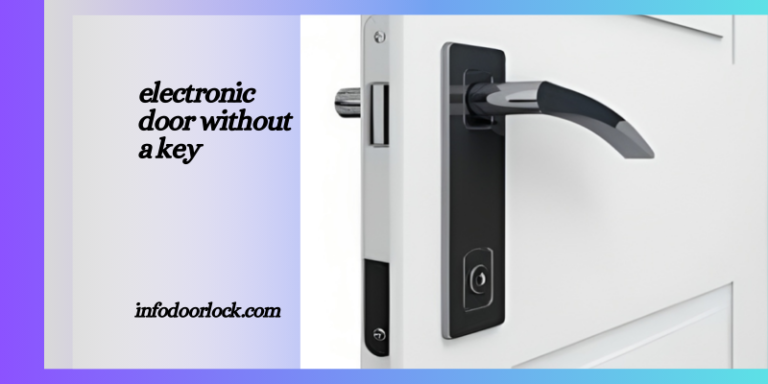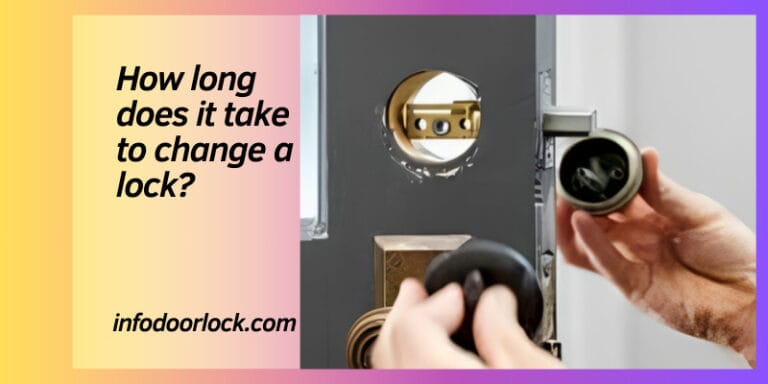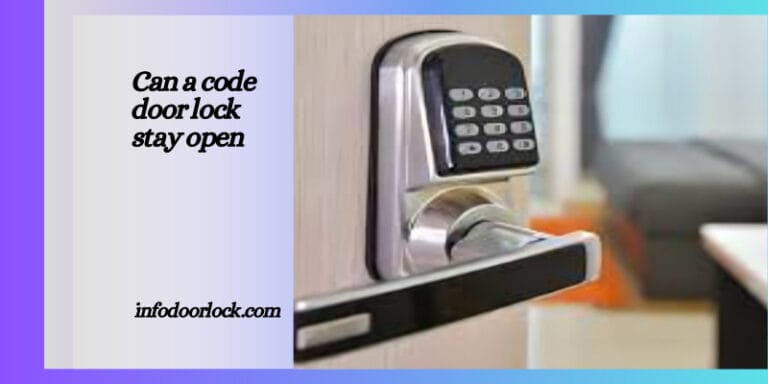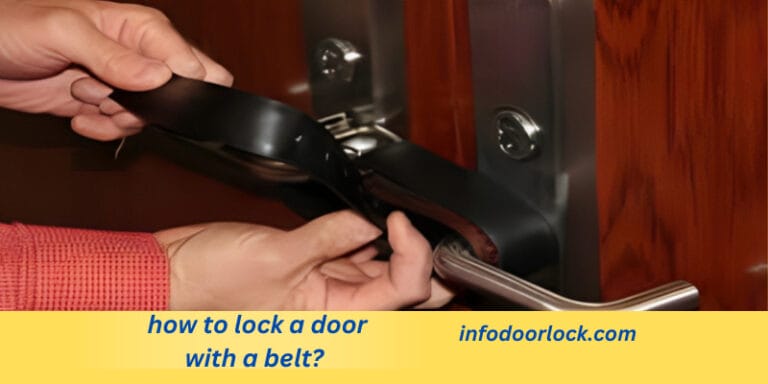How to Open Electronic Door Lock Without Key?” (EASY GUIDE)
Getting locked out of your own home or office due to the fact you’ve misplaced an important thing in an electronic lock may be a traumatic and inconvenient situation. Electronic door locks, which often provide superior security and comfort, can end up being quite the hurdle while entry is denied due to misplaced or forgotten keys or malfunctions.
The need to gain entry without the authentic secret’s a venture many face, leading to a look for secure, dependable, and non-negative methods to bypass these present day locking mechanisms. This manual aims to offer realistic and stable solutions for starting electronic door locks without a key. Our focus will be on strategies that owners and people can adequately enforce without compromising the integrity of their locks or protection structures.
We will explore a number of strategies, equipment, and recommendations to help you regain access to your space while also ensuring that these solutions adhere to prison requirements and moral practices. Whether you’re managing a clever lock, keypad lock, or another form of electronic locking gadget, this guide will equip you with the information to efficiently address the situation.

Safe and Reliable Solutions for Opening Electronic Door Locks Without a Key
1. Use the Backup Mechanical Key
- Many digital locks come with a mechanical key override. Check in case your lock has one and use it to gain right of entry.
2. Reset or Recode the Lock
- Some electronic locks will let you reset or recode them using a grasp code or by following a selected reset process. Refer to the lock’s guide for instructions.
3. Utilize a Mobile App
- If your electronic lock is Bluetooth or Wi-Fi-enabled and related to a smart domestic device, you may be able to liberate it from the usage of the related cell app.
4. Contact Customer Support
- The manufacturer’s customer support can regularly provide guidance or emergency access to answers, particularly for your lock version.
5. Hire a Professional Locksmith
- For a secure and assured answer, keep in mind hiring a professional locksmith who’s skilled with digital locks. They possess the tools and know-how to open the lock without harm.
6. Battery Replacement or Power Reset
- If the lock is unresponsive because of a low battery or an electronic glitch, replacing the batteries or performing a strength reset would possibly restore access.
7. Check for Override Codes
- Some electronic locks have override codes that may be utilized in emergencies. These codes should be kept in a secure, however handy, vicinity.
8. Magnetic Lock Bypass
- For magnetic electronic locks, a robust uncommon-earth magnet can every now and then be used to cause the discharge mechanism. However, this approach must be used cautiously and ethically.
9. Temporary Removal or Disassembly
- In severe cases, cautiously doing away with or disassembling the lock might be essential. This should be completed as a remaining lodge, and preferably through experts to keep it from damage.
A Complete Guide to Understanding Electronic Door Locks
- The use of electronic door locks is a significant advancement in the security of entry into residential and business buildings. These cutting-edge devices offer a powerful substitute for conventional mechanical locks by combining comfort, security, and innovation.
- This guide will explain what electronic door locks are all about, how they differ from conventional locks, and what common varieties there are, such as keypad, biometric, and smart locks.
What is an electronic door lock?
- Electric motors are used by electronic door locks and safety devices, to secure and unlock doors. Unlike traditional locks that require a physical key, digital locks function via the command of an electrical impulse, which can be brought about in various ways, which include a keypad, a far off manager, a telephone app, or biometric verification.
- Because this generation offers keyless entry, remote access, and the option to personalize human access stages, it offers a higher degree of ease and security.
The Ways in Which Mechanical and Electronic Locks Differ
- The working mechanisms of mechanical and electronic locks are where they diverge most. Mechanical locks require physical movement from pins, tumblers, or levers in order to operate, and a physical key is required to release them.
- Electronic locks, however, make use of digital additives to actuate the locking mechanism, which can be engaged or disengaged through digital signals.
Moreover, digital locks offer better features that are not available in mechanical locks, including:
Remote Access:
- Ability to lock or unencumbered doors remotely using a cellphone or laptop.
User Access Customization:
- Option to provide or limit admission to unique customers at specific instances.
Audit Trails:
- Capability to track and document access and exit times, providing precious records for security tracking.
Integration with Home Automation Systems:
- Seamless compatibility with other clever home devices for a cohesive and handy home automation revel in.

Common Types of Electronic Locks
Keypad Locks:
- These locks require a numerical code to be released, disposing of the need for a bodily key. Users can input their particular codes into the keypad, making it a handy alternative for more than one customer.
- Keypad locks are best for areas requiring restrained access, such as workplace areas or steady storage rooms.
Biometric Locks:
- Leveraging advanced technology, biometric locks use precise bodily characteristics, which include fingerprints, facial recognition, or iris scans, for authentication.
- These locks offer a high degree of safety, as biometric data is nearly impossible to duplicate or proportion, making them perfect for touchy areas.
Smart Locks:
- Smart locks are the epitome of domestic automation and safety, permitting customers to manipulate and screen their locks via smartphone apps.
- These locks can integrate with numerous clever domestic gadgets and systems, assisting features like far off get for control and actual-tmanagingors on lock fame.
- Smart locks are suitable for tech-savvy customers and those searching for strength and managing their finances.
RFID and Card Access Locks:
- These locks use radio-frequency identification (RFID) or magnetic stripe playing cards for entry. Common in resorts and office buildings, those structures permit clean right of entry to control and may be speedily reprogrammed to hold safety.
Bluetooth Locks:
- Utilizing Bluetooth generation, those locks interact with your smartphone to provide access, offering convenience without the need for internet connectivity.
- Ideal for personal use, Bluetooth locks frequently include features like proximity unlocking, where the door routinely unlocks as you method together with your phone.
Common Causes of Lockouts and How to Avoid and Fix Them
Being locked from your automobile, residence, or administrative center can be an irritating and frequently terrifying event. Knowing the commonplace causes of lockouts enables you to take preventative action and know what to do on the occasion when you discover yourself in a scenario like this. Let’s discover a number of the most unusual offenders behind lockouts and provide fixes to hold you stable.
1. Forgotten or Lost Keys
- Dropping your keys or forgetting to convey them with you is one of the most common reasons for lockouts. This can appear in any and all situations, especially in our nerve-racking day by day lives, where it is straightforward to overlook little but important things.
Prevention:
Routine Check:
- Make it a habit to do a short pat-down before leaving the house or locking your vehicle to make sure you have your keys.
Key Finder:
- Purchase a Bluetooth key finder to clip onto your keychain. Your phone may be able to track these devices, which makes finding misplaced keys easier.
Spare Key Strategy:
- Leave a spare key with a dependent on a buddy, family member, or neighbor. Alternatively, recollect a securely installed lockbox out of the doors of your property that holds a spare key.
2. Malfunctioning Lock or Dead Batteries
- Like various other mechanical instruments, locks can malfunction due to wear and tear over time. Dead batteries are a frequent problem with digital locks that can keep the lock from operating.
Prevention:
Continual Upkeep:
- Make sure your locks are in good operating order by giving them regular maintenance and inspections. Check for indications of wear and tear and lubricate them as necessary.
Battery Checks:
- For electronic locks, regularly test the battery status and update batteries as needed. Many clever locks have signs or app notifications for low battery status.
3. Misaligned Door Lock
A door that’s not properly aligned with its body can cause a lock that is not characteristic. This misalignment may be because of changes in temperature and humidity, a flawed installation, or wear and tear.
Prevention:
Regular Inspections:
- Periodically, take a look at the alignment of your doorways, especially with changes in seasons. Look for gaps between the door and the frame, and make certain the lock latches effectively.
Professional Help:
- If you notice widespread misalignment, it is probably time to call in a professional. A locksmith or chippie can alter your door or body to make sure everything lines up correctly.
Final Thoughts
Getting locked out can disrupt your day and pose a safety danger. By knowing the common reasons for lockouts and taking proactive measures, you could limit the probability of them taking place. Remember, prevention is fundamental, but if you do find yourself locked out, don’t forget to call an expert, a locksmith, who will allow you to regain access safely and efficiently.
A Complete Guide to Preparing Before Attempting to Unlock
It is probably inconvenient to be locked out of your private home, vehicle, or place of work. It is crucial that you keep in mind to take some precautionary measures first, even before you take any dramatic measures to recover access. By taking those precautions, you no longer only shield your private home from useless harm but additionally assure your own safety. This is what you have to do:
1. Check for Simple Solutions First
- Often, the perfect solution is right at your fingertips, and checking for those can prevent time, money, and pressure.
Backup Keys:
- Always check if you or a person nearby has a spare key. It’s commonplace to overlook this simple solution in a moment of panic.
Reach out for help:
- If you live with your own family, individuals, roommates, or have entrusted a neighbor or friend with a spare key, contact them. Their availability ought to quickly resolve your situation.
Hidden Spares:
- If you have hidden a spare key somewhere around your property, now is the time to use it. However, remember to be discreet about retrieving it to ensure your safety.

2. Ensure the Lock is Not Connected to an Alarm System
Modern safety systems frequently combine alarms with locks, specifically in motors and commercial residences. Attempting to forcibly open those locks can cause alarms, leading to felony issues or alerting security services.
Understand Your Security System:
- If you have a security machine established, be familiar with how it interacts with your locks. Knowing this could prevent accidental alarms.
Check for indicators:
- Many structures have visible indicators indicating they may be armed. Before attempting any unlocking, make sure those indicators aren’t energetic.
Consult Documentation:
- If you’re uncertain, consult your safety machine’s consumer manual. It typically carries information on how the system interacts with locks and how to accurately bypass them if needed.
3. Assess the Situation Calmly
- In a lockout situation, it is easy to act swiftly. However, taking a moment to frivolously examine your scenario can lead to higher selections.
Analyze the urgency:
- Determine how essential it is to get the right of entry without delay. If it’s not urgent, you would possibly choose to await a less invasive solution, like someone arriving with a spare key.
Consider the consequences:
- Before attempting to pressure open a lock, remember the potential harm to the lock, door, or your car. The price of maintenance may outweigh the urgency of getting admission.
4. Explore Non-Damaging Entry Methods
- If you’ve long past the above steps and nevertheless need to gain access, do not forget methods that won’t damage your property.
Lock Picking Tools:
- If you’re professional in the use of lockpicking equipment, this will be a non-unfavorable choice. However, be aware that in many locations, sporting this gear without being an authorized locksmith is illegal.
Credit Card Trick:
- For positive varieties of latch bolt doorways, sliding a credit score card among the door and frame can push the latch lower back. Note that this doesn’t work on deadbolts and may harm your card.
Final Advice
If you’ve exhausted all non-invasive options without fulfillment, it might be time to name an expert locksmith. Locksmiths have the equipment, know-how to enjoy unlocking doors without inflicting damage. Remember, at the same time as it is tempting to resolve the issue quickly, retaining the integrity of your lock and door ought to be a concern to ensure your ongoing security.
Safe and Lawful Ways to Unlock Electronic Door Locks Without a Key
Comparing digital door locks to traditional mechanical locks, the previous provide accelerated safety and luxury. But what takes place if you’re locked out and do not have a key or get admission to the code? Here are numerous methods for unfettered electronic door locks that do not compromise the integrity of the lock and don’t forget the significance of legality.
1. Using the Override Feature
- Many digital locks include a mechanical key override characteristic for emergencies or when electronic mechanisms fail. This feature lets you use a conventional key to unlock the door.
Locating the Override:
- The override lock is regularly concealed to maintain the aesthetic and security of the door. It is probably underneath a panel or cover close to the keypad or get right of entry to point. Consult the lock’s guide to find its genuine region.
Using the Override Key:
- Once you locate the override, use the furnished key (it’s critical to realize where this secret’s saved before emergencies rise up) to free up the door. This method is straightforward and preserves the lock’s integrity.
2. Resetting the Lock
- Some digital locks have a reset button that restores manufacturing unit settings, doubtlessly allowing admission. However, this method must be used carefully.
Finding the Reset Button:
- The reset button is normally placed inside the lock’s housing, requiring the door to be open to get admission. In some cases, there might be an external reset alternative, but this varies by version and emblem.
Using the Reset Button:
- If accessible, pressing the reset button will revert the lock to its default settings. Be conscious that this might erase all person codes and configurations, requiring reprogramming.
3. Bypass Techniques
There are numerous technical strategies to bypass electronic locks, but these must be approached with warning, each for felony and technical reasons.
Technical knowledge Required:
Bypass techniques can range from hot-wiring to exploiting vulnerabilities in the lock’s layout. These strategies require substantial technical information and may potentially damage the lock or void warranties.
Legality:
- It’s vital to make sure that any attempts are both prison and moral. Using these techniques without the right authorization may be taken into consideration, even if you own the assets.
4. Contacting the Manufacturer or a Professional Locksmith
When all else fails or you are not comfortable trying to unencumbered the door yourself, reaching out to an expert is a pleasant course of action.
Manufacturer Support:
- If the lock remains under guarantee or guide, the manufacturer may offer assistance or advice on unlocking it. This is specifically beneficial for complicated or excessive-security locks.
Professional Locksmiths:
- A licensed locksmith has the tools and know-how to liberate digital locks without causing damage. They can also advocate for security and are probably able to reprogram or repair the lock as desired.
Final Thoughts
While getting locked out of an electronic lock may be tough, it is important to approach the state of affairs with patience and caution. Always prioritize strategies that maintain the lock’s integrity, and make sure you are performing within criminal barriers. When unsure, expert help is your most secure and simplest choice, safeguarding both your security and your lock’s functionality.

DIY Tips and Warnings for Unlocking Locks
Attempting to liberate yourself can be tempting, especially in a lockout scenario. However, while a few DIY techniques may be effective, they come with risks. Below are some fashionable suggestions and warnings for those thinking about a DIY method for unlocking locks.
DIY Tips
Stay calm and analyze:
- Before attempting something, take a deep breath and assess the scenario. Sometimes the solution is less complicated than it appears.
Consult the manual:
- If you are handling a digital lock, the consumer manual can be a goldmine of records, along with emergency unencumbered techniques.
Use Proper Tools:
- If you make a decision to apply tools (like lock picks for a traditional lock), ensure they’re suitable for the task. Incorrect equipment can cause damage.
Seek Guidance:
- Look for dependable tutorials or courses. Online platforms can provide step-with the aid-of-step commands for numerous types of locks. However, make certain that the source is official and the technique is safe.
Practice Patience:
- Rushing can lead to mistakes. Whether you are seeking to choose a lock or skip a protection characteristic, take your time to keep away from pointless damage.
Write FAQS How to Open Electronic Door Lock Without Key
1. What do I have to do if I’m locked out of my electronic lock?
Answer: If you locate yourself locked out, the first step is to check if there is an alternative entry technique that you’ve formerly set up, inclusive of a pin code, a fingerprint, or a mobile app that can free up the door. Many electronic locks offer multiple approaches to freeing them in case one method fails. If no opportunity is available for installation, contacting a professional locksmith or the lock producer’s customer service is the most secure and simplest option.
2. Can I pass my digital door lock using a reset code?
Answer: Some electronic door locks may also have a reset characteristic that can be used in case of a lockout. However, this commonly calls for physical access to a reset button on the indoor part of the lock, which won’t be handy in case you’re completely locked out. It’s vital to seek advice from the lock’s manual or producer assistance for precise guidance on your lock version, as attempting to reset the lock without proper understanding can result in an everlasting lockout or harm to the lock.
3. Is it possible to apply a regular key or grasp code to open electronic locks?
Answer: Unlike traditional mechanical locks, electronic locks generally do not have a “commonplace key” or “master code,” which can open a couple of locks. Each lock is normally programmed with precise access credentials for security purposes. However, in controlled environments like lodges or condo complexes, the administration may have a grasp code for emergency admission. Using any such code without authorization is unlawful and unethical.
4. Can I hack my digital door lock to gain admission?
Answer: Attempting to hack into a digital door lock is strongly discouraged and can be illegal. Hacking can compromise the safety of the lock and potentially render it unusable, leading to expensive repairs or replacements. If you’re facing a lockout, it is first-rate to explore felony and moral answers, which include contacting a locksmith or the lock producer for help.
5. What preservation steps can save you lockouts with electronic door locks?
Answer: Regular preservation can help save you from unexpected lockouts. This includes checking battery tiers and replacing them earlier than they run out, ensuring any physical keys or backup get right of entry to methods are comfortably on hand, updating the lock’s firmware if wished, and periodically checking the lock’s functionality to ensure all opportunities to get admission to techniques are operational. Setting up alerts for low batteries or different problems, in case your lock supports them, can also be a proactive measure to avoid lockouts.

